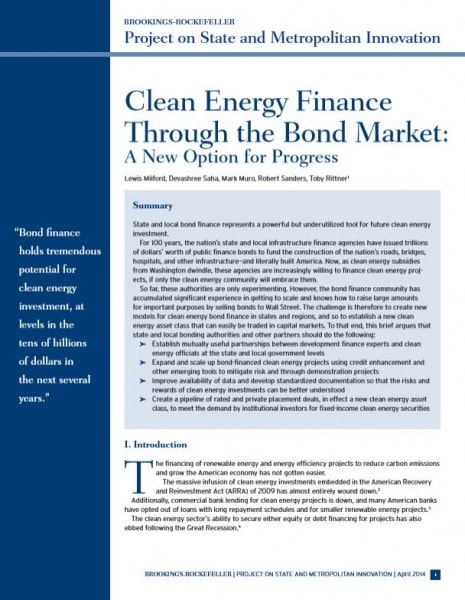April 16, 2014
Clean Energy Finance Through the Bond Market: A New Option to Finance Climate Mitigation and Adaptation
By Lewis Milford

If there is any good news on promising approaches to solve these climate problems, it’s worth a note. Regarding the need for significantly more financial investment in clean energy, Clean Energy Group, Brookings Institution Metropolitan Policy Program, and the Council of Development Finance Agencies just released a new paper on a powerful but underutilized tool for future clean energy investment: state and local bond finance. The report, “Clean Energy Finance through the Bond Market: A New Option for Progress,” is available here.
For 100 years, the nation’s state and local infrastructure finance agencies have issued trillions of dollars’ worth of public finance bonds to fund the construction of the nation’s roads, bridges, hospitals, and other infrastructure—financing that literally built America. Now, as clean energy subsidies from Washington dwindle, these agencies are increasingly willing to finance renewable energy and energy efficiency projects, if only the clean energy community embraces these new bond finance tools.
So far, these authorities are only experimenting in bond finance for clean energy. However, the bond finance community has accumulated significant experience in getting infrastructure projects to scale and knows how to raise large amounts needed capital by selling bonds to Wall Street. The challenge is therefore to create new models for clean energy bond finance in states, and to establish a new clean energy asset class that can easily be traded in capital markets.
To that end, the paper argues that state and local bonding authorities and other partners should do the following:
- Establish mutually useful partnerships between development finance experts and clean energy officials at the state and local government levels
- Expand and scale up bond-financed clean energy projects using credit enhancement and other emerging tools to mitigate risk and enable more demonstration projects
- Improve availability of data and develop standardized documentation so that the risks and rewards of clean energy investments can be better understood
- Create a pipeline of rated and private placement deals, a new clean energy asset class, to meet the demand by institutional investors for fixed-income clean energy securities.
And it’s happening. Already, bonding has been embraced in smart ways in New York, Hawaii, Morris County, NJ, and Toledo as well as other locations described in the paper. Now, it’s time for states and municipalities to scale up the use of bonds for clean energy purposes. If they can do that, it will be yet another instance of the nation’s states, cities, and the private sector stepping up with a major breakthrough at a moment of federal drift.
And there is even more at stake. The report comes just as the global scientific community has underscored the urgency of finding new ways to finance no-carbon technologies at massive scale. The bottom line is that we need to finance clean energy the same way we have financed large-scale public infrastructure like schools, water systems, and airports—with investment that will benefit generations, financed at low bond rates. Our current way of financing clean energy not only makes it too expensive, but it simply cannot meet climate mitigation and adaptation demands we will face in the next few decades.














